The Path to Automation with Josh Barkin
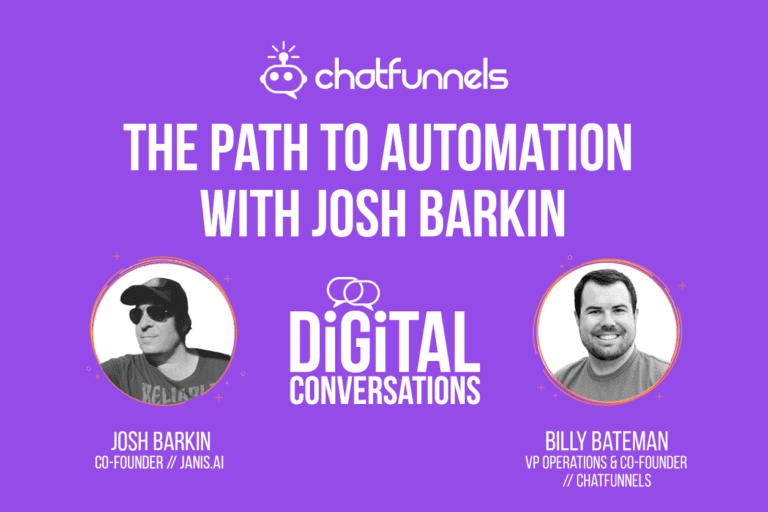
Overview: This week on digital conversations with Billy Bateman Josh Barkin of Janis.ai shares the path to automation. Including how to integrate, personalize and adapt AI into your conversational experiences.
Guest: Josh Barkin- Josh Barkin is the Co-founder and CEO of Janis.ai, a SaaS platform that helps businesses integrate AI into their customer experiences and achieve their marketing and support automation goals.
Listening Platforms:
Billy: All right, everybody, welcome to the show today. I have got Josh Barkin, Co-founder of janis.ai. He is my guest, Josh welcome to the show, thanks for being on
Josh: Well thank you very much for having me.
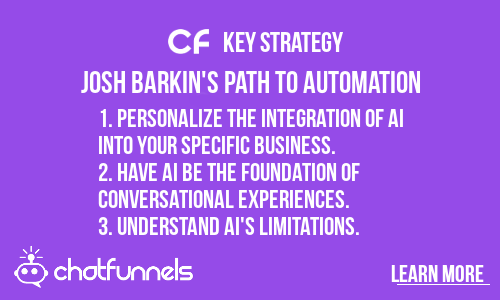
Billy: So, today, we’re going to talk a little bit about the Janis, Janis.ai, how people are using your technology on Facebook Messenger to use AI there but before we get into that, just tell us a little bit about yourself and what Janis.ai is.
Josh: So, I am a currently that the CEO and founder, co-founder of Janis and prior to that I have been a co-founder of a number of startups over the years. I got into the conversational AI space and early 2016, so I was an early adopter and you know we’ve just been learning, just like everybody else, this has kind of been a Wild West type of space, with a lot of learning, a lot of rapid growth, a lot of opportunity to solve some really big problems and really, I guess just prior to Janis I was I ran a mobile gaming studio and that’s essentially how I met my co-founder, we were both running mobile gaming studios and we saw conversational experiences as a new paradigm for building product and then we saw channels like slack and then very quickly Facebook Messenger as new ways to reach customers and engage them. But, yeah so, we’ve that’s essentially how Janis started.
I should also point that out that you know early in 2016, Facebook declared that you would be able that you would be able to chat with a business like a friend and my partner and I both saw that as Facebook’s pitch to the business world into the investor community and we knew it wasn’t going to be a magic bullet, we knew that people were going to get really excited and there was a lot of hype in the space at that time and we just knew that it wasn’t just having a number of years of experience building software products and having a sort of a general understanding of the underlying technology that it just doesn’t work that way and businesses we anticipated that businesses were going to be struggling with this very quickly.
So, that’s— when I say we got started early we anticipated problems early we got the work and we sought to you know help businesses see past the hype and understand that it’s more like you need to manage a path to automation, you know, it’s not like you just plug in Siri here or something and it just works you need you need to you need to start with a foundation and then you need to build on that foundation and ultimately every goal or every business has the goal to adds, to put their business on autopilot, whether it’s for lead generation or customer support which are the two main use cases on Facebook and so there is a path to getting there and so that’s the opportunity that we ended up capitalizing on was businesses were struggling to integrate AI, they bought into the hype very early and then shortly thereafter, there was a lot of frustration you know why doesn’t it work what do you mean we have to train our AI, how do we do that the technology is targeted to developers and data sign to this and also most importantly how do we retain our customers what when the technology fails?
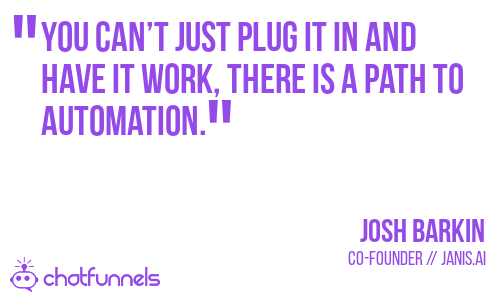
So, those are number of problems that we started building you know I guess capabilities for what became Janis which is an AI assistant that helps businesses manage the path to automation, it helps businesses integrate AI into their customer experiences and then achieve their marketing and support automation goals.
Billy: Awesome you know that’s really what interested me, it’s like okay every there’s always all this talk about AI and like everybody who’s got a bot or a conversational marketing solution they almost all claim like oh yeah we have some AI but you’re selling this to two marketers and sales people generally or founders are the small company and like we don’t know how to train AI and what they have is it’s like I don’t know how to work with this they or it’s not it’s half-baked and say okay like it doesn’t really work and you end up with unhappy customers but if you can train that AI which is really one of the harder problems then you can actually make it work.
So, before we get into that a little bit, I do want to ask you one more question just about yourself, so you are Josh on social media, I am trying to figure out who you are, what’s one thing that I wouldn’t be able to figure out, I wouldn’t know about?
Josh: It’s funny because I do have actually sort of two personas on social media, everybody in the business world, probably what if they look me up, they would see they would say well he’s in it he’s running an AI management company but everywhere I see he’s a musician and so they would think that I play that I’m a full-time musician and my friends and family and I guess people more in my social circles, not my professional network, you know they have no idea that I’m— they think I’m a full-time musician, so I do play in I do play in bands but mostly because I studied music right up until the end of college and that was that, I grew up as a musician and then shortly after college ended, this was you know in the 90s and I was that that didn’t seem like a viable career, I didn’t seem like a viable careers but the it was the emergence of the Internet as sort of a new medium and I was an early adopter is there as well but yeah that’s the funny cool that I have those two personas.
Billy: Cool! So, what instruments do you play?
Josh: I play keyboard, I’m classically trained and I studied Jack, that’s four numbers and I sing, I play guitar, I’ve actually had a multi-instrumentalist but my main instrument is his keyboard and I still play in these bands, it’s actually interesting I usually use playing in a band too as an analogy for running a startup because you know you bring all these people together and you have to all listen to each other and you’re going to have times where things are out of sync and don’t sound good and you have to you know keep practicing to get everything in sync and but when you when things are insane and everybody’s listening together and great things can happen and then you get that gratification from an audience, the same way you would get from building product and bringing that to market, it’s very similar.
Billy: That’s a great way to think about it, yeah
Josh: I think playing in a band, well I think first of all playing musical instrument is a really good outlet, it’s really good for your mind and creative thinking and you know everyone has, everyone should have an outlet you know whether it’s you know working out or you know just doing something away from the computer, and now your minds are kind of developed and you know so that that’s a good part but I think it’s also made me a better a better co-founder and team leader just bye-bye understanding the dynamics of what makes a band successful and you know and then applying those methodologies to building a team around her product.
And my co-founders a musician too, that was sort of one of the common things that we had when we got together, we both played in bands, we both liked the same music and so that there was some common ground we kind of understood both we both agreed on those same concepts, so.
Billy: Great, awesome man, well let’s I mean let’s get into the meat of it again. So, with Janis, what you guys have is something to help you train your AI and one of the use cases I thought was particularly interesting was you have integrations with ManyChat and ChatFuel and I thought it would be great to help, you know tell us how your customers are leveraging those integrations to engage with their customers.
Josh: Yeah so, just in terms of like you know the sort of the value proposition for Janis training is a part of it but by taking a step back just being able to connect AI was the first problem that we solved and that was the audience that we focused on initially was, we saw that a lot of the a lot of the activity in the bot space was on Facebook and messenger and we saw that the market was being dominated by two companies, specifically ChatFuel and ManyChat, those two companies account for 70% of the Facebook Messenger chat box, so the chat box being built with Facebook messenger are built with those two I guess conversational design tools but neither of those companies have AI, so you know we we’d see that the people, it was very easy to build a bot but then as soon as a customer would send a message the business would be able to handle it because the Box just didn’t have the capability to understand those messages.
So, the first, the way that other people would say is oh you need AI, well then that was the first problem that we had to solve was okay well how do you you get AI into that bot, like how do you connect AI and they would say well you need dialogue flow, dialogue flow is Google’s AI and each of the big tech companies have been actively invested in this technology, Google, IBM, Microsoft, the technology isn’t perfect obviously but they’re continuing to invest in the underlying technology, the problem is how does that technology become integrated into the ChatFuel or ManyChat bot so that’s so that a business can benefit from it.
So, that the first problem we saw was getting that, is helping to integrate that technology and so we built the AI assistant to essentially act as an which is Janis to onboard the user and help them get connected, so if you’ve never heard of dialogue flow or Google AI and you just chat with Janis, you don’t need to be a developer, you don’t need to have any technical skills, you just chat with our bot and Janis will set you up with a Google AI account in the cloud for you and then you know give you a key that you could just drop in your BOTS, we’re kind of like as a Zapier for AI, you know how Zapier makes these?
Billy: Yeah

Josh: So, that was the first problem, is okay, how do you connect AI? The second problem that we had to solve was the training part, okay now you’ve got AI and you need to train the AI and so what we wanted to do was we wanted to help accelerate the times of value right, because training AI takes time and nobody understands better how to do it, so we spent a fair amount of time pre-training AI so a customer can benefit immediately, so we created this, we trained the AI using thousands of messages anonymous messages, the most common things that users say and we created this AI starter kit, so Janis will when you connect a bot, Janis will actually install this AI for you and then you just send your bot messages and your bot will immediately be responsive. So, it was all about accelerating the time to value that doesn’t mean the bots going to understand everything got it but it certainly allows you to experience the benefits of the technology without investing all that time and to get to a point where you can rely this value, so immediate time to value.
And then the third part was okay that’s going to provide them with a foundation that they can build on because we built that those AI models, that pre-trained AI, so it’s set up in a way that they can easily scale a business and continue to build on that or customize it for you know whatever niche you’re in, whether you’re real estate or finance or restaurants or e-commerce and those are the main use cases right, just being able to understand questions and convert those into leads and and/or commerce and then customer service like just automating your app, thank you.
Billy: So, on that second step where you’re able to send messages to the bot and it’ll begin training it and seem like okay what’s working, what’s not, is that something where if I already built a bot and I’ve got something on Facebook messenger, maybe it’s been going well, maybe not, I can take those conversations and upload them into yours to jumpstart it or is it and plug it in and then it starts training.
Josh: So, we look at training AI as not something that has one path, in other words as a business you’re going to have different workflows, every business is different and so we’ve created these training experiences that will serve a sort of a wide range of workflow.
So, let me give you an example, Janis integrates into slack, right? And those slack allows a team to collaborate on an AI integration, so instead of having to use, instead of — you don’t need to be technical we’ve built this into intuitive AI training tools right into slack and because lack of this collaborative, sales and marketing can all collaborate on what users stay, so they just like send messages and then they get replies and then they can add responses, so it’s very simple and intuitive, it’s not very deep but it least allows non-technical people or at least the people that own the customers experience, to be active participants in that training process, so Janis for slack provides a collaborative AI training.
We’ve done an integration into Google sheets because our target market, they all know how to use a spreadsheet program and so we’re by building tools right into Google sheets we’re able to accelerate adoption of not only conversational an AI the technology but it’s because it’s integrating in a product we’re able to speed adoption of Janis as a service.
We have something called live training, so you connect Janis to Facebook, you just add Janis to like a Facebook page, maybe you probably already have a mini chat or a chat bots already connected to your Facebook page, so you had Janis and it sits alongside those bots, Janis will monitor your live conversations, analyze the messages and then deliver them to you in slack and you can then train your AI to learn from those conversations, so Janis will transcribe the conversation and for every message you receive you can then categorize it and train it and then you and then Janis also with that monitoring that sort of monitoring your conversations and analyzing the messages, Janis delivers actionable alerts, so when your bot can’t respond you’ll get an alert, when customers like sentiment is negative, so when customers seem like angry or frustrated, it’ll alert you and those alerts are all actionable.
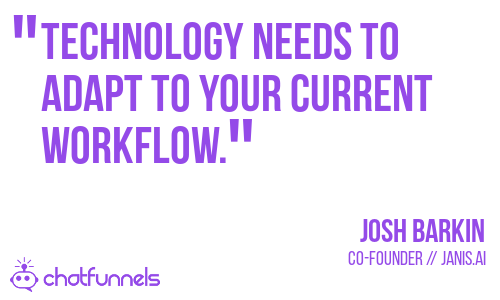
So, Janis will help you will pause your AI and help you take over live and you know all of that happens within a collaborative workspace like slack and we’re actually now just building out an AI workspace for the web, so you can think of it as sort of a AI training as something that is it’s kind of a broader requirements to integrate conversational AI but how you get from A to B to C, how you sort of grow that path, we look at it as something that needs to adapt to your current workflow because if it becomes something that is overly complicated or you’re going to have to adopt new software or it just becomes, it can’t be this process that is going to be overwhelming, so that’s why we I really like the live training mode because it just hates your existing conversations and helps you take those and make every message something as it comes in.
So, first you’re more hands-on and you are live but it’s like this sort of hybrid experience where somebody’s chatting but also training the AI at the same time or more because it’s collaborative, a customer service agent can be you know chatting with the customer and then somebody else can be actually categorizing all the messages that you want to, then so and over time you’ll you know increase your automation capabilities by understanding the actual messages you receive rather than guessing what people say.
Billy: For sure, especially with that real-time Brits, I love the sentiment if the sentiments negative giving your team an alert so that they can jump in and take over, I love that because I mean the bots, the automation it’s great, it’s valuable but ultimately like you know business is still people to people and if the bots not helping them, let’s get a real person in there and then I love that and then the real-time training and that’s something we strive for you know with customers using drift or intercom is every day we go in and look at those conversations and categorize like okay did the bot perform as it’s supposed to, what can we change or we seeing trends like are people consistently like indicating they’re having a negative experience in this workflow
Josh: Yeah and I think it’s true. I mean, just what you said before which is that I think it’s important to understand what today’s conversation are like AI can do and what it can’t do and understanding its limitations and you know that’s just part of the underlying problem was that everyone bought into the hype originally expected that you know because it was pitched as chat with the business like a friend, well it’s I think that’s more of an ideal and so there’s always–AI is good at some things and humans are always going to be better at other things and so if Janis can help you achieve anywhere between 20 and 80-percent automation then its scale, that’s significant cost savings and if your use cases customer support and certainly you can boost revenue 24/7 if that experience is delightful which AI helps you.
But at the same time Janis will know when to bring you into the loop and then makes those alerts actionable, so there’s a lot of capabilities that Janis provides and so it really is I think training is sort of the bigger ongoing solution that we’re working on multiple dimensions but at the end of the day Janis is AI assistant that’s going to help you manage that entire integration, train, retain, optimize, all of the sort of pain points that people have with an AI integration, Janis is kind of there working with you.
Billy: Yeah, and then training something with AI that never ends really, like we’ll come in and we’ll set up bots for a customer and they’re like okay we’re good, like you guys can go, we send you guys away like well you could but your business is going to change, your customers are going to change, what they need like the world in the last month has changed for everyone with this COVID-19
Josh: Yeah, for sure
Billy: And we’ve had to adjust, so continually in training, like you’ve got to just stay after with the AI and it just will get better and sometimes it your fundamental shifts in either how your customers want to buy or how you’re going to sell and you’re going to start over again, so.

Josh: Yeah, for sure and there’s also just some general conversational design best practices that that company should take right, so they can’t, it doesn’t have to be human versus AI, we do see you know Janis has this kind of copilot mode so the you know if you’re if you do spend time training your AI and then you do, you take a life and chat with your customer well the AI is still working in the background, so the AI will suggest responses for a live agent and you can click you can push those responses with one click see so it does booths live chat productivity time too but in terms of like best practices I think it’s important right like the bot is going to fail, it just, it happens and it’s not about, it’s not about the bot failing, it is about how you manage that situation and water and what kind of strategies do you have you know everything from just, you know maybe they eat the customer needs to rephrase their message and then the AI understand or maybe instead of it being the customer sending a message and the bot or the AI doesn’t have a response, maybe the bot suggests possible responses, kind of like search results and then and then you know at least the customer isn’t frustrated but they’re given options and then maybe if people and this happens on a lot too is they see it’s automation and then they’ll try and break it, so they’ll send messages to just to test how good the automation is or and they’ll start asking things that are about like the weather, a little bit question and we do that all the time and you know it’s really a best practice to refocus the customer on what the bots can actually do to say you know to identify that the message is out of scope of what the bot can do but then gracefully refocus the user and say here are things I can help you with immediately and then give them a bunch of options.
And then obviously you need to be able to account for you know scenarios where people just don’t want to chat with a bot, they need a human because it’s a they know it’s a problem that won’t be solved with automation, so that those are other alerts that Janis, you know it Janis is behind the scenes listening for keywords like help an operator and things like and you can actually assign alerts to any actionable event, so if the AI detects that it’s a lead because you’ve trained it to recognize when people say I’m interested in whatever it is, you can add an AI alert to that and those get sent to the right people and then you have like a workspace like slack where you can segment people on a team into channels, if you’re familiar with slack, so you have like you know sales people in the channel or customers poor in the channel and so it’s all, Janis does all that routing intelligently using AI too
Billy: Well, that’s great man, this has been this has been really good. So, before I let you go, I’ve got one more question for you if somebody wants to start leveraging AI in their bike move beyond just you know like a basic logic flow with buttons, what’s your first piece of advice to them just start doing that?
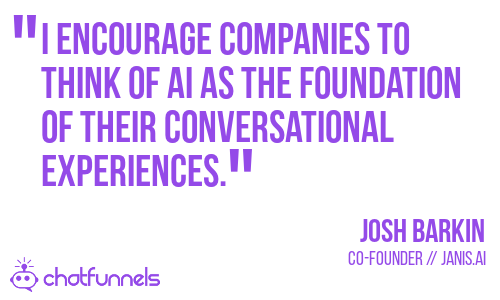
Josh: It really depends on where that the business is starting, so a lot of businesses will start with something like a ChatFuel or in ManyChat because they make it easy right it’s like Wix for chat bots, that’s what they do they make it super easy to build a bot and then they come in and they realize that they that they don’t that the body is just not responsive because they don’t have AI and so they plug us in and sometimes that’s harder to do right, because you know they have to but it’s something we support but I encourage businesses to think of it more like AI as the foundation of their conversational experience.
I mean think of it, you have to think of it like building a house, you could have all the buttons and galleries and you know plugins into other thing like if you start with that and then you start with the AI after, it’s like building up a mansion on stilts but when you start with AI then you’re building the foundation of your conversational experience and then you can layer on all these things, like buttons and integrations and all that on top of it and that positions you to scale your business for the future because everyone knows that voices is the future and interacting with you know Google assistant, an Amazon Alexa in the home and those experiences are powered by the same AI that are ManyChat tool users are using today.
So, if you train your AI for your ManyChat or chat bot then you’re building a foundation that then will support the future.
Billy: Awesome, okay man, well it’s been good, thanks for taking a few minutes and people want to contact you and continue the conversation, where can they find you?
Josh: www.janis.ai
Billy: Okay
Josh: www.janis.ai and they’re free to join our community as well and learn from other users and how they’re benefiting from the technology.
Billy: Awesome! Thank You Josh.
Josh: Thanks so much for having me today.
Billy: Okay, we’ll chat later
Josh: Okay, take care.
